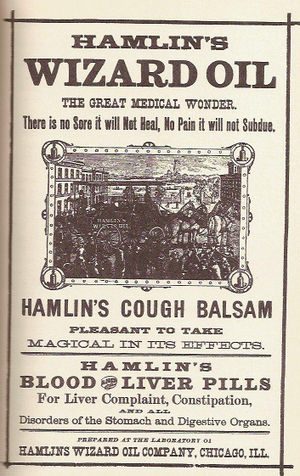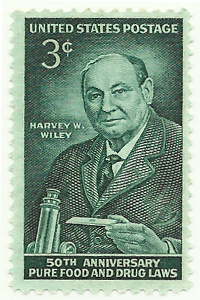ARTICLE SUMMARY:
In 1906, amid public outcry over the uncontrolled use of poisonous preservatives and dyes in foods, cure-all claims for worthless and dangerous “remedies,” along with intense political opposition, the landmark precursor of today’s US Food and Drug Administration—the Pure Food and Drug Act—became law.
Significant political, social, and other shifts that were to have lasting consequences took place around the world at the beginning of the 20th Century. In 1906, Britain began sweeping social reforms after the landslide election of Liberal Henry Campbell-Bannerman as Prime Minister, Finland became the first European country to allow women to vote and run for office, and the German Reichstag passed new legislation to increase Germany's naval fleet in order to keep pace with Britain as a major naval power.
 Also in that year, a major shift of another kind took place along the San Andreas Fault in San Francisco, California. The most disastrous earthquake in American history—an estimated 7.8 magnitude on the Richter scale—took place on April 18 at 5:12 a.m. local time. San Francisco, which then had a population of about 410,000 (880,000 today), was devastated by the earthquake and the subsequent fire, which lasted several days and destroyed 80% of the city. Nearly 4,000 people died, with up to 300,000 left homeless, and an estimated $350 million in damages (roughly $10 billion in today’s dollars). Temblor tidbit of the day: the honor of the largest earthquake ever recorded goes to a magnitude 9.5 earthquake in Chile in 1960, according to the University of California, Berkeley Seismology Lab.
Also in that year, a major shift of another kind took place along the San Andreas Fault in San Francisco, California. The most disastrous earthquake in American history—an estimated 7.8 magnitude on the Richter scale—took place on April 18 at 5:12 a.m. local time. San Francisco, which then had a population of about 410,000 (880,000 today), was devastated by the earthquake and the subsequent fire, which lasted several days and destroyed 80% of the city. Nearly 4,000 people died, with up to 300,000 left homeless, and an estimated $350 million in damages (roughly $10 billion in today’s dollars). Temblor tidbit of the day: the honor of the largest earthquake ever recorded goes to a magnitude 9.5 earthquake in Chile in 1960, according to the University of California, Berkeley Seismology Lab.
Also in 1906, prior to the hard-fought enactment of the first in a series of landmark US consumer protection laws, labels on so-called “remedies” could make claims like this:
- Is your baby keeping you up at night? Calm him down with this soothing syrup laced with moderate amounts of opium!
- Are you balding? Wipe on some of this special potion, and just like that you will be cured!
- Hamlin’s Wizard Oil: The Great Medical Wonder. There is no sore it will not heal, no pain it will not subdue. (see label image here)
 Since the late 1800s, chloroform, cocaine, heroin, methamphetamine, and other drugs had been sold as miracle solutions for everything from sore throats and toothache to coughs, insomnia, and depression. The fact that these dangerous products were sold everywhere and to anyone seems unbelievable by today's standards!
Since the late 1800s, chloroform, cocaine, heroin, methamphetamine, and other drugs had been sold as miracle solutions for everything from sore throats and toothache to coughs, insomnia, and depression. The fact that these dangerous products were sold everywhere and to anyone seems unbelievable by today's standards!
Following more than 20 years of reform efforts and bitter opposition to federal regulation by congress as well as food and drug manufacturers, the landmark Pure Food and Drug Act—the precursor to today’s US Food and Drug Administration (FDA)—was signed into law by President Theodore Roosevelt on June 30, 1906. It provided, for the first time, federal regulation of adulterated, mislabeled, or harmful foods, liquors, drugs, and medicines (and many years later, medical devices). The statute, enforced by the Bureau of Chemistry in the Department of Agriculture, went into effect January 1, 1907. It regulated food and drugs moving in interstate commerce, defined "misbranding" and "adulteration" for the first time, forbade the manufacture, sale, or transportation of poisonous patent medicines, and prescribed penalties for each.
The Act was introduced, with strong support from President Roosevelt, in the wake of shocking investigative journalist exposés by reporters (termed “muckrakers”) such as Samuel Hopkins Adams, author of The Great American Fraud series of articles for Collier's Weekly, in which he thoroughly documented how the pharmaceutical industry often put the general public's health at risk.
Harvey Washington Wiley, MD, Chief Chemist in the United States Department of Agriculture, also played a significant role in the passage of this  important Act. In 1902, Wiley was appropriated $5,000 by Congress to study the effects of a diet consisting in part of the various common preservatives used at the time (often to disguise insanitary production practices) on healthy human volunteers. His subjects would eat food laced with borax, benzoate, formaldehyde, sulfites, and salicylates. These "poison squad" studies, and the clear results showing that preservatives were harmful to health, drew national attention to the need for a federal oversight of food and drugs. Wiley fought an unwavering food adulteration campaign, lecturing across the nation and organizing groups—particularly women’s groups—to support the passing of the Pure Food and Drug Act. (It should be noted that Wiley’s 29-year fight did not end when the Act was passed, as enforcement proved difficult. Some legal battles went all the way to the Supreme Court, including the famous “Coca Cola trial,” which resulted in a reduction of the amount of caffeine in the beverage.)
important Act. In 1902, Wiley was appropriated $5,000 by Congress to study the effects of a diet consisting in part of the various common preservatives used at the time (often to disguise insanitary production practices) on healthy human volunteers. His subjects would eat food laced with borax, benzoate, formaldehyde, sulfites, and salicylates. These "poison squad" studies, and the clear results showing that preservatives were harmful to health, drew national attention to the need for a federal oversight of food and drugs. Wiley fought an unwavering food adulteration campaign, lecturing across the nation and organizing groups—particularly women’s groups—to support the passing of the Pure Food and Drug Act. (It should be noted that Wiley’s 29-year fight did not end when the Act was passed, as enforcement proved difficult. Some legal battles went all the way to the Supreme Court, including the famous “Coca Cola trial,” which resulted in a reduction of the amount of caffeine in the beverage.)
The Pure Food and Drug Act was renamed the Food and Drug Administration (FDA) in 1930, and then was largely replaced by the much more comprehensive Federal Food, Drug, and Cosmetic Act of 1938. This act, along with numerous amendments, remains to this day the basis for FDA regulation of nearly all foods, drugs, biological products, cosmetics, medical devices (which had its beginnings in 1966 with the Fair Packaging and Labeling Act), tobacco, and radiation-emitting devices. Today, the FDA regulates more than 190,000 different medical devices, manufactured by more than 18,000 firms in more than 21,000 facilities worldwide.
#PureFoodandDrugAct #FDA #FoodandDrugAdministration #HarveyWashingtonWiley #HarveyWiley #TheodoreRoosevelt #SamuelHopkinsAdams #TheGreatAmericanFraud #ProgressiveEra #ProgressiveReforms #SanFranciscoEarthquake #1906 #SanAndreasFault #HenryCampbellBannerman #womensuffrage #Reichstag #poisonsquad #CocaColaTrial #FairPackagingandLabelingAct #InMedTechHistory #CommunityBlog #MedTechStrategist #MyStrategist #medicaldevice #medtech #tracyschaaf
![]() Trial MyStrategist.com and unlock 7-days of exclusive subscriber-only access to the medical device industry's most trusted strategic publications: MedTech Strategist & Market Pathways. For more information on our demographics and current readership click here.
Trial MyStrategist.com and unlock 7-days of exclusive subscriber-only access to the medical device industry's most trusted strategic publications: MedTech Strategist & Market Pathways. For more information on our demographics and current readership click here.
